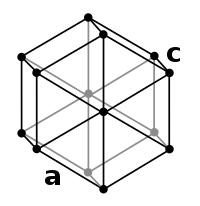
Photo from wikipedia
Abstract Hydrogen separation membranes based on a heated metal foil of a palladium alloy, offer excellent permeability for hydrogen as a result of the solution-diffusion mechanism. Here, the possibility to… Click to show full abstract
Abstract Hydrogen separation membranes based on a heated metal foil of a palladium alloy, offer excellent permeability for hydrogen as a result of the solution-diffusion mechanism. Here, the possibility to separate hydrogen from the mixture of Natural Gas (NG) and hydrogen (NG+H2) with various NG concentrations using Pd, PdCu53 and PdAg24 hydrogen purification membranes is demonstrated. Hydrogen concentrations above ∼25% (for Pd and PdCu53) and ∼15% (for PdAg24) were required for the hydrogen separation to proceed at 400 °C and 5 bar pressure differential. Hydrogen permeability of the studied alloys could be almost fully recovered after switching the feed gas to pure hydrogen, indicating no significant interaction between the natural gas components and the membranes surface at the current experimental condition. Hydrogen flux of the membranes at various pressure differential was measured and no changes in the hydrogen permeation mechanism could be noticed under (NG 50%+H2) mixture. The hydrogen separation capability of the membranes is suggested to be mainly controlled by the operating temperature and the hydrogen partial pressure.
Journal Title: International Journal of Hydrogen Energy
Year Published: 2019
Link to full text (if available)
Share on Social Media: Sign Up to like & get
recommendations!